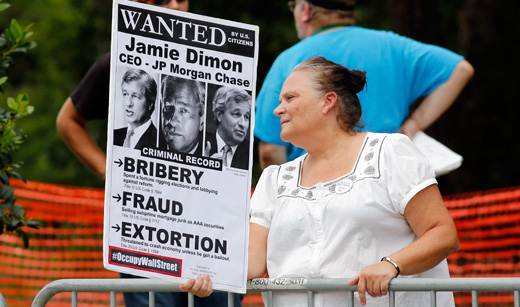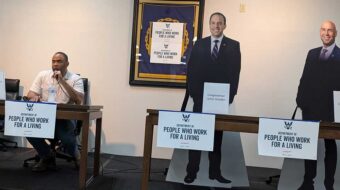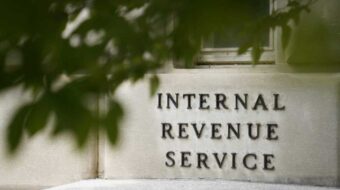
Newt Gingrich, America’s most over-the-top political self-promoter, thinks we may have a problem with our politics. Said Gingrich in a national TV interview: “I think the current system is rigged, frankly, in favor of the wealthy.”
Gingrich, of course, should know. His campaign for the GOP presidential nod rested on the shoulders of a single billionaire. Now that billionaire – casino king Sheldon Adelson – has switched horses. In mid-June, Adelson announced a $10 million contribution to a Mitt Romney super PAC and hinted at “limitless” contributions to come, as much as $100 million in all.
Meanwhile, Politico reports several other conservative billionaires are busy raising a $1 billion war chest for November. That billion bucks would sit on top of the $800 billion the official GOP campaign apparatus expects to spend. Some perspective: John McCain spent $370 million in 2008, Barack Obama $750 million.
So have we reached a plutocratic tipping point – or passed it? Here’s more information and inspiration to help you frame an answer:
CEO pay at America’s seven largest banks averaged 100 times the median U.S. household income in 1989 — and over 500 times that median in 2007.
European bankers have spent the last 20 years trying to catch up to that gravy train, and that catching up seems about to get much harder. The European Parliament, the Financial Times reports, appears poised to limit – this summer – all bank annual bonuses and related incentive pay to a total that does not exceed an individual banker’s straight salary. Bonus pay today typically runs up to 10 times straight payouts.
Belgian Green Party lawmaker Philippe Lamberts led the push for the new banker pay cap. His measure would apply both to bankers working at European Union-based banks anywhere in the world and to EU-based staff of U.S. and Asian banks.
We’re giving our “petulant plutocrat of the week” award to Jamie Dimon, the CEO of JPMorgan Chase. We still haven’t figured out an award for the lawmakers who were supposed to quiz him. Maybe a dunce cap? Or a lollypop? They’re appropriate.
Dimon, CEO of America’s top bank, testified at the Senate Banking Committee. That panel could have grilled Dimon on JPMorgan Chase’s recent $3 billion trading loss – and nailed him for opposing government regs that would prevent bankers from speculating with federally insured deposits. But no grilling ever came!
Most committee senators count JPMorgan as a major campaign donor. One senator did note JPMorgan benefited from taxpayer bailouts. Blasted back Dimon, incorrectly: “You’re factually wrong.”
And that multi-billion trading loss? Dimon did sort of pledge to “claw back” pay from those responsible. He made no pledge to claw back himself. Dimon has pocketed $138 million since taking over as JPMorgan CEO in 2006.
The Federal Reserve again counted up America’s personal wealth – and omitted the nation’s 400 richest from the final tally. But the new figures, even without those super-rich, show a divide still deepening.
In the middle of Middle America – in a suburb just outside Dayton, Ohio – funeral home owner Anne Dunbar noticed a rather unnerving new trend. Families used to want the obituary notices that Dunbar writes up to include a pitch for donations to their dear departed’s favorite charity. Some families are now requesting notices that ask for donations toward their funeral expenses. With funerals costing five figures, no wonder.
You won’t find Anne Dunbar’s story – or any other anecdote about the collapse of America’s middle class – in the Fed’s latest Changes in U.S. Family Finances study. What you will find: The most exhaustive set of numbers yet on the devastation the Great Recession and decades of rising inequality before it wreaked on average families.
Most Americans, the new data help make plain, have essentially spent the last 20 years on a go-nowhere treadmill, at best. They’re working longer and harder and have zero new wealth to show for their labor. As a matter of fact, they went in reverse.
In 2010, the net worth of the median, or typical, American family was $77,300, about the same net worth, after inflation, the typical family held back in the early 1990s. The median is the point where half of all families are above it and half are below.
Many families have the bulk of their net worth as equity in their homes. The pop of the housing bubble zapped that. Between 2007 and 2010, notes the Fed, typical families lost 38.8% of net worth and housing’s crash accounted for three-fourths of the drop.
But home values, the Fed reports, haven’t been the only aspect of middle class economic life to take a significant hit. Incomes plunged as well. The take-home of the typical family, after taking inflation into account, dropped 7.7% in the three years after 2007, down to $45,800. That’s on top of a smaller slide in the three years before 2007, when the economy was supposedly in a recovery from the 2001 recession.
These numbers come from the Federal Reserve’s Survey of Consumer Finances, an intense series of field interviews they conduct every three years. Researchers completed just under 6,500 of these in-depth interviews for the 2010 survey. The Federal Reserve selected 5,000 of these families through a random sampling of U.S. households. But random samplings don’t generate enough wealthy households to give a statistically rich enough sense of life at America’s economic summit.
To help spotlight that summit, Federal Reserve researchers supplemented their basic 2010 sample with a list of another 1,500 families, all affluent, identified through tax records.
The resulting data from all these interviews paint the most statistically compre-hensive portrait of personal wealth in America available anywhere. But this portrait has one gaping hole. For confidentiality reasons, the Fed excludes from the survey interview process any family that appears on the annual Forbes 400 list of America’s richest. (No Wal-Mart family members, for example.)
That exclusion means the new Federal Reserve numbers for 2010 understate by $1.37 trillion the total wealth of that year’s Forbes 400, and America’s actual level of wealth concentration.
The Federal Reserve’s Changes in U.S. Family Finances report doesn’t much concentrate on that concentration. It offers no specific wealth and income breakouts for America’s top 1%. Analyses at that level will have to wait until scholars get their hands on the micro data the Federal Reserve’s 2010 Survey of Consumer Finances generated.
The new Federal Reserve study gives us income and wealth breakdowns for America’s top 10%. Those families made over $142,000 each in 2010. These families averaged $2.9 million in net worth, about 15 times the $199,000 average net worth of families in America’s middle 20%. Between 2001 and 2010, America’s top 10% gained net worth. Over that same span, all income brackets below the top 10% lost net worth.
Major swatches of American families below the top 10% tier, the Federal Reserve numbers also show, remain deep in debt. In 2007, only 56.4% of families found themselves able to do any saving. In 2010, even fewer families, 52%, saved any money.
Those families struggling the hardest? Federal Reserve data give that unsought distinction to families headed by 35- to 44 year-olds. Just 47.8% of these families did any saving in 2010. Between 2007 and 2010, their net worth fell a stunning 54%, down to $42,100.
Add together the net worth of over 80,000 of these families in 2010 and you’ll have a fortune that equals the net worth of a single average deep pocket on that 2010 Forbes list of America’s 400 richest.
Veteran labor journalist Sam Pizzigati edits Too Much Online, a newsletter about wealth and income sponsored by the Institute for Policy Studies’ Program on Inequality and the Common Good.
Photo: Protestors outside JPMorgan Chase after the annual stockholders meeting May 15, in Tampa, Fla. CEO Jamie Dimon kept his job after he disclosed a $2 billion trading loss by the bank. Scott Iskowitz/AP











